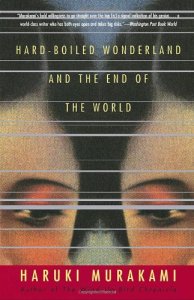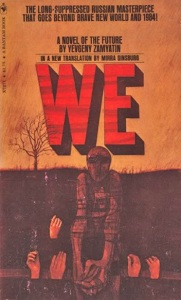Taking a look at the Gollancz Masterwork series, a number of bloggers have remarked upon the bias of the list: predominately male American and British (90%?) authors prior to 1980. Joachim posed the question, What if? and led a band of bloggers to expand the list based on their own preferences. The result has been great! Considering this bias of Gollancz, Joachim has focused on female writers while Jesse and I have focused on novels published after 1980, but one additional bias stirs my interest: language.
On the Gollancz Masterwork list, only two books are from foreign languages: from Russian, Arkady and Boris Strugatsky’s Roadside Picnic (1971/1977) and, from Czech, a small collection of Karel Capek’s R.U.R. (1923) and War with the Newts (1936/1939). I haven’t been able to procure either the Strugatsky novel or the Capek collection. So, I can’t offer my opinion on them… but I can suggest a little more translated fiction for the series.
My six authors and languages: 1) Haruki Murakami (Japanese), 2) Jose Saramago (Portugese), 3) Franz Kafka (German), 4) Stanislaw Lem (Polish), 5) Yevgeny Zamyatin (Russian), and 6) Frigyes Karinthy (Hungarian).
Murakami, Saramago, and Kafka
When I talk about translated literary fiction, three names (and languages) instantly pop into my mind, two are modern classics and the other a classic classic, respectively: Murakami and Saramago and Kafka. If you don’t know those names, then you probably don’t read translated fiction. These three names are mainstream yet all have an edge to their writing that wavers between realism and fantasy, a gray area that some call mystic and others call ethereal.
 I’m not a wide reader of Murakami; I’ve only read Wild Sheep Chase (1982/1989) and Hard-Boiled Wonderland and the End of the World (1985/1991). I can’t suggest a book I haven’t read so I’ll suggest the most SF-esque story of the two: Hard-Boiled Wonderland. What starts as a urbane personal drama spirals into a surreal dream—in the reality and the fantasy, the protagonist (of sorts) interacts with both with full consciousness and intent. He lives his life as he would in both and the result is a curious introspection on our motivations, expectations, and causations.
I’m not a wide reader of Murakami; I’ve only read Wild Sheep Chase (1982/1989) and Hard-Boiled Wonderland and the End of the World (1985/1991). I can’t suggest a book I haven’t read so I’ll suggest the most SF-esque story of the two: Hard-Boiled Wonderland. What starts as a urbane personal drama spirals into a surreal dream—in the reality and the fantasy, the protagonist (of sorts) interacts with both with full consciousness and intent. He lives his life as he would in both and the result is a curious introspection on our motivations, expectations, and causations.
 Likewise, I don’t have much exposure to Saramago, but Blindness (1995/1997), while not even twenty years old yet, hit so many right notes in my mind that I can’t shake the feeling even since reading it years ago. Yes, it’s a disaster novel where nearly everyone becomes blind—not the most original premise, surely, but show me another novel that probes the human condition from deterioration and pity of their dilemma to circumstances of a different extreme. Much like Camus’s The Plague (1947/1948), the schism between cope and hope is driven by the contagion, an impersonal microscopic hunter, which reflects the personal and very real threat of nefarious humans.
Likewise, I don’t have much exposure to Saramago, but Blindness (1995/1997), while not even twenty years old yet, hit so many right notes in my mind that I can’t shake the feeling even since reading it years ago. Yes, it’s a disaster novel where nearly everyone becomes blind—not the most original premise, surely, but show me another novel that probes the human condition from deterioration and pity of their dilemma to circumstances of a different extreme. Much like Camus’s The Plague (1947/1948), the schism between cope and hope is driven by the contagion, an impersonal microscopic hunter, which reflects the personal and very real threat of nefarious humans.
 As for Kafka, I’ve only had the pleasure and opportunity to read a collection that includes “Metamorphosis” (1915) and five other penetrating stories. Again, I can’t recommend something I haven’t read, so this goes on the list! The collection—Metamorphosis and Other Stories (1971)–is a window into Kafka’s soul, a seemingly very personal portrait of one man’s repressive isolation. The portrayal of isolation is interesting/devastating/concerning in its many different forms: enforced isolation, the symptom of monomania from isolation, growing separateness from others, and isolation as cause of death. All of this occurs when an idle life is shaken to its core by an unseen causation, a mode of fantasy that changes the reality.
As for Kafka, I’ve only had the pleasure and opportunity to read a collection that includes “Metamorphosis” (1915) and five other penetrating stories. Again, I can’t recommend something I haven’t read, so this goes on the list! The collection—Metamorphosis and Other Stories (1971)–is a window into Kafka’s soul, a seemingly very personal portrait of one man’s repressive isolation. The portrayal of isolation is interesting/devastating/concerning in its many different forms: enforced isolation, the symptom of monomania from isolation, growing separateness from others, and isolation as cause of death. All of this occurs when an idle life is shaken to its core by an unseen causation, a mode of fantasy that changes the reality.
Lem, Zamyatin, and Karinthy
Again… I don’t have a wide knowledge of translated science fiction but that’s why I’ve started this blog—to read more, learn more, and share it with others who hold a similar interest. Three translated science fiction books that I’ve read and loves are the following:
 Stanislaw Lem’s Solaris (1961/1970) is a popular choice among fans for inclusion into Gollancz’s Masterworks. Indeed, it is one hell of an atmospheric novel! My choice is a collection of Lem’s which I enjoyed much more: The Cyberiad (1965/1974). The fifteen stories about robots constructing robots is a cavalcade of amusement and intellect, of folly and philosophy. I don’t think there’s another book like it… something which can be said for much of Lem’s bibliography. In The Cyberiad, there’s (1) the humor of absurdity, (2) the satire of technological progress, and (3) the philosophy of knowledge. There’s a little something for everyone but most importantly, taken as a whole, is should appeal to all because it’s an absolute work of art.
Stanislaw Lem’s Solaris (1961/1970) is a popular choice among fans for inclusion into Gollancz’s Masterworks. Indeed, it is one hell of an atmospheric novel! My choice is a collection of Lem’s which I enjoyed much more: The Cyberiad (1965/1974). The fifteen stories about robots constructing robots is a cavalcade of amusement and intellect, of folly and philosophy. I don’t think there’s another book like it… something which can be said for much of Lem’s bibliography. In The Cyberiad, there’s (1) the humor of absurdity, (2) the satire of technological progress, and (3) the philosophy of knowledge. There’s a little something for everyone but most importantly, taken as a whole, is should appeal to all because it’s an absolute work of art.
 Yevgeny Zamyatin… we’ll have to wind back the clock nearly a hundred years to find the first publication of Zamyatin’s short but concise dystopian (before dystopias were cool) novel We (1921/1924). Named with a number, D-503 lives a life of drudgery and wishes to escape the OneState by flying off into space, which is pretty much the furthest and remotest area outside the OneState. With his hopes of spaceflight, he discovers something else—he has a soul. However, his discovery is dangerous as his newly found spirit within is often melted from the brain by the OneState. Before Huxley’s Grave New World (1932), Orwell’s 1984 (1949), and Bradbury’s Fahrenheit 451 (1953), there only stood Zamyatin’s We and all other followed suit. We set the precedence for modern dystopian fiction.
Yevgeny Zamyatin… we’ll have to wind back the clock nearly a hundred years to find the first publication of Zamyatin’s short but concise dystopian (before dystopias were cool) novel We (1921/1924). Named with a number, D-503 lives a life of drudgery and wishes to escape the OneState by flying off into space, which is pretty much the furthest and remotest area outside the OneState. With his hopes of spaceflight, he discovers something else—he has a soul. However, his discovery is dangerous as his newly found spirit within is often melted from the brain by the OneState. Before Huxley’s Grave New World (1932), Orwell’s 1984 (1949), and Bradbury’s Fahrenheit 451 (1953), there only stood Zamyatin’s We and all other followed suit. We set the precedence for modern dystopian fiction.
 Frigyes Karinthy is an obscure name outside of Hungarian fiction. His one piece of science fiction is a sequel or sorts… a sequel to Jonathon Swift’s Gulliver’s Travels (1726, amended 1735). With Swift’s stories, Gulliver went on four separate voyages. While many so-called fifth and sixth voyages have been written since the book’s publication, Karinthy wrote two additional voyages which have stood the test of time: “Voyage to Faremido” (1916) and “Capillaria” (1921), as collect in Voyage to Faremido and Capillaria (1966). If you’ve read Boulle’s Monkey Planet (1963), you’ll know that the writing style was annoyingly objective and dry… bad translation, bad writing, I don’t know. But Karinthy’s travels of Gulliver are far from this form—the observations are inflective, personal and vague. The observations say less about society (as Swift’s Travels had done) and more about the narrator—Gulliver—and the author—Karinthy.
Frigyes Karinthy is an obscure name outside of Hungarian fiction. His one piece of science fiction is a sequel or sorts… a sequel to Jonathon Swift’s Gulliver’s Travels (1726, amended 1735). With Swift’s stories, Gulliver went on four separate voyages. While many so-called fifth and sixth voyages have been written since the book’s publication, Karinthy wrote two additional voyages which have stood the test of time: “Voyage to Faremido” (1916) and “Capillaria” (1921), as collect in Voyage to Faremido and Capillaria (1966). If you’ve read Boulle’s Monkey Planet (1963), you’ll know that the writing style was annoyingly objective and dry… bad translation, bad writing, I don’t know. But Karinthy’s travels of Gulliver are far from this form—the observations are inflective, personal and vague. The observations say less about society (as Swift’s Travels had done) and more about the narrator—Gulliver—and the author—Karinthy.
Check out the other lists:
Joachim Boaz: yet-to-featured and female authors prior to 1980
Admiral.Ironbombs: classic novels and authors that have slipped through the crack
Couch to Moon: Truly MASTERworks and the endangered species
Ian Sales: classics from 1950-1994
SFPotpourri: post-1980s selection of modern classics
Jesse: a similar post-1980s selection of modern classics

Excellent — I was hoping someone would add some more foreign language works to the lists! I’ve only read Lem and have been trying to track down Zamyatin, and the rest I’ll look into as they sound fascinating.
Pingback: My Eight Additions to SF Masterworks | Battered, Tattered, Yellowed, & Creased
Pingback: My Recommendations for Future Gollancz SF Masterworks Selections | From couch to moon
I love Lem and Zamyatin as well.
Have you read Lem’s A Perfect Vacuum (not SF)? A series of book reviews of non-existent books. Darn good.
Ah, you mentioned this to me a while ago. I’d pick up anything with Lem’s name on it!
I assume you are aware of the following site referencing translated spec fic, but just in case:
http://translatedsf.thierstein.net/tiki-index.php
It’s difficult enough getting one’s hands on some English-first publications, let alone as a second language. This is my roundabout way of saying Good Luck!!
Found that a few weeks after I started my blog. It’s big but not comprehensive or up-to-date, sadly.
Pingback: Updates: My Top 10 SF works (pre-1980) for inclusion in the Gollancz Masterwork series | Science Fiction and Other Suspect Ruminations